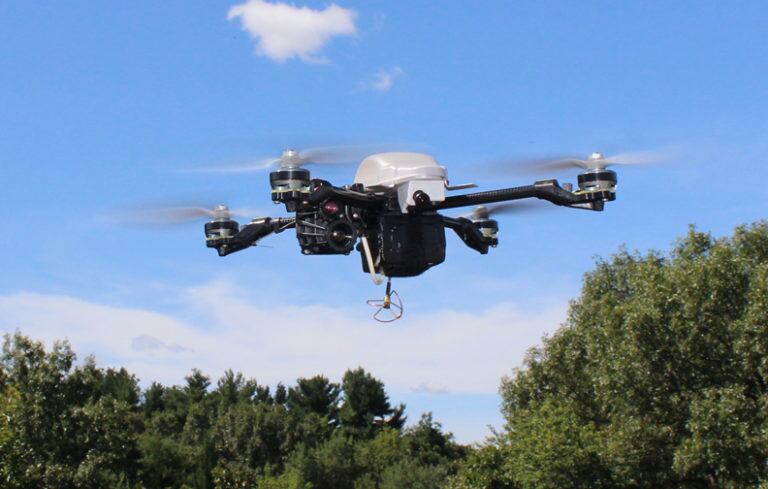Rather than convoys of heavy, vulnerable trucks or people-filled helicopters dropping off supplies to units in remote locations, a “drone pack” could continually resupply on demand to Marines with the push of a button.
That’s the vision of one Marine major who recently showcased the work he and a team of developers have done at Quantico Marine Corps Base to industry and media.
The “Hive Final Mile” demonstration used hive-like pods filled with racks of small, commercial drones that would carry small items ― an MRE, weapon magazine, canteen ― to the requested location.
RELATED

Marine reserve Maj. Christopher Thobaben sketched out the idea on a paper pad at his kitchen table about a year ago. The major has spent his military career in motor transport and works as a supply chain logistics consultant in civilian life.
Having seen the devastating effects bombings and ambushes when moving troops and gear through known supply routes, Thobaben thought, why not create a drone pack that could be sent on autonomous missions, reacting to the needs of the Marine in the field? That system could deliver tiny amounts of gear in waves, from batteries, to first aid to ammunition or food.
He shared a noncombat example of the infrastructure problems when Hurricane Maria hit Puerto Rico.
Thousands of containers of supplies reached the island within days but still sat at the ports or nearby months later for lack of a way to get their contents out to people in remote location.
People died for lack of medications, such as insulin for diabetics.
“That drone can drop off a week’s worth of insulin,” Thobaben said.
Thobaben’s project is under the NexLog, a Marine Corps’ logistics accelerating program, that did its first public capability demonstration this month. The next step is to acquire funding to continue building out the program to eventually become an adopted, permanent program with ongoing funding for development and deployment.
Many observers following the technology say that “drone swarms” hold a lot of promise for a variety of missions. The swarm concept uses drones that talk to each other and move in concert, much like a swarm of insects.
But those developments are still likely years away from fielding, Thobaben said.
His team looked to pack technology, “dumb drones” in his wording, that talk only to the main station and then fly out on preplanned routes, a much easier technology that’s already available.
The system can be set up to simply drop off a pile of MREs, one at a time to continuously resupply a squad, platoon or company out in the field. But what’s more promising is the controllable aspect at the lowest levels.
“An individual warfighter wants what they need today, not necessarily what they need for the next three days,” Thobaben said.
In less than three months, using Intelligence, Surveillance and Reconnaissance software developed by the Defense Advanced Research Projects Agency and the Air Force Research Lab, a team of developers from Soar Tech, Sentien Robotics, Scientific Research Corporation, Salesforce, Xcraft and Drotek/Intel put together the hardware and software to make up to 32 drones operate at short ranges with light loads to accomplish this vision.
The foundation is the software architecture, Thobaben said. That underlying system has proven the concept and would require only modifications to drone capabilities and autoloading drones to scale up to “thousands” of drones operating on this system in less than two years.
The drones still must be hand loaded with their cargo but automating that hive feature should take less than two years to develop, Thobaben said.
An individual lance corporal can use a smart device to see what is available in the “hives” nearest his or her position. The Marine can then make its request and the system will pull from its stocks. For example, if one hive had three loaded rifle magazines and another had 12 in stock, the drones would pull from both to meet the Marine’s need.
At the same time the supply officer could monitor the supply boxes in real time to decide when to drop off a box or restock certain items.
At the open-air landing zone field where the demonstration took place, researchers also showcased automated obstacle avoidance capabilities.
The drones move more slowly in a denser tree line, 2 to 5 meters per second as compared to 15 meters per second for unimpeded travel. But the devices do sense and avoid the obstacle.
The next drone will have already been told the route adjustment by the system and can shift its course as it arrives in the area.
In an ideal world, Thobaben said, supply officers would preload containers with the necessary gear for the troops in their area. The containers and a mix of drones would then be dropped off between the main force and at an ideal range to resupply troops distributed in the field.
Todd South has written about crime, courts, government and the military for multiple publications since 2004 and was named a 2014 Pulitzer finalist for a co-written project on witness intimidation. Todd is a Marine veteran of the Iraq War.




